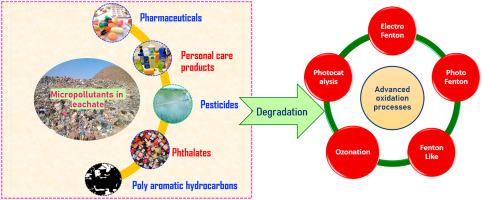Chemosphere ( IF 8.1 ) Pub Date : 2021-09-08 , DOI: 10.1016/j.chemosphere.2021.132216 Lakshmi Pisharody 1 , Ashitha Gopinath 2 , Milan Malhotra 3 , P V Nidheesh 2 , M Suresh Kumar 2

|
Landfilling is the most prominently adopted disposal technique for managing municipal solid waste across the globe. However, the main drawback associated with this method is the generation of leachate from the landfill site. Leachate, a highly concentrated liquid consisting of both organic and inorganic components arises environmental issues as it contaminates the nearby aquifers. Landfill leachate treatment by conventional methods is not preferred as the treatment methods are not much effective to remove these pollutants. Advanced oxidation processes (AOPs) based on both hydroxyl and sulfate radicals could be a promising method to remove the micropollutants completely or convert them to non-toxic compounds. The current review focuses on the occurrence of micropollutants in landfill leachate, their detection methods and removal from landfill leachate using AOPs. Pharmaceuticals and personal care products occur in the range of 10−1 to more than 100 μg L−1 whereas phthalates were found below the detectable limit to 384 μg L−1, pesticides in the order of 10−1 μg L−1 and polyaromatic hydrocarbons occur in concentration from 10−2 to 114.7 μg L−1. Solid-phase extraction is the most preferred method for extracting micropollutants from leachate and liquid chromatography (LC) - mass spectrophotometer (MS) for detecting the micropollutants. Limited studies have been focused on AOPs as a potential method for the degradation of micropollutants in landfill leachate. The potential of Fenton based techniques, electrochemical AOPs and ozonation are investigated for the removal of micropollutants from leachate whereas the applicability of photocatalysis for the removal of a wide variety of micropollutants from leachate needs in-depth studies.
中文翻译:

城市垃圾渗滤液中有机微污染物的存在及其高级氧化工艺的有效处理
填埋是全球最广泛采用的城市固体废物管理处置技术。然而,与这种方法相关的主要缺点是垃圾填埋场会产生渗滤液。渗滤液是一种由有机和无机成分组成的高浓度液体,会污染附近的含水层,从而引发环境问题。通过传统方法处理垃圾渗滤液不是首选,因为这些处理方法对去除这些污染物的效果不大。基于羟基和硫酸根自由基的高级氧化过程 (AOP) 可能是一种有前途的方法,可以完全去除微污染物或将它们转化为无毒化合物。目前的审查重点是垃圾渗滤液中微污染物的发生,他们的检测方法和使用 AOP 从垃圾渗滤液中去除。药品和个人护理产品出现在 10-1至超过 100 μg L -1而邻苯二甲酸酯低于可检测限至 384 μg L -1,农药 浓度为 10 -1 μg L -1和多环芳烃浓度为 10 -2至 114.7 μg L -1. 固相萃取是从渗滤液中提取微量污染物的最优选方法,液相色谱 (LC) - 质谱仪 (MS) 用于检测微量污染物。有限的研究集中在 AOP 作为降解垃圾渗滤液中微污染物的潜在方法上。研究了基于 Fenton 的技术、电化学 AOP 和臭氧化从渗滤液中去除微污染物的潜力,而光催化从渗滤液中去除各种微污染物的适用性需要深入研究。











































 京公网安备 11010802027423号
京公网安备 11010802027423号